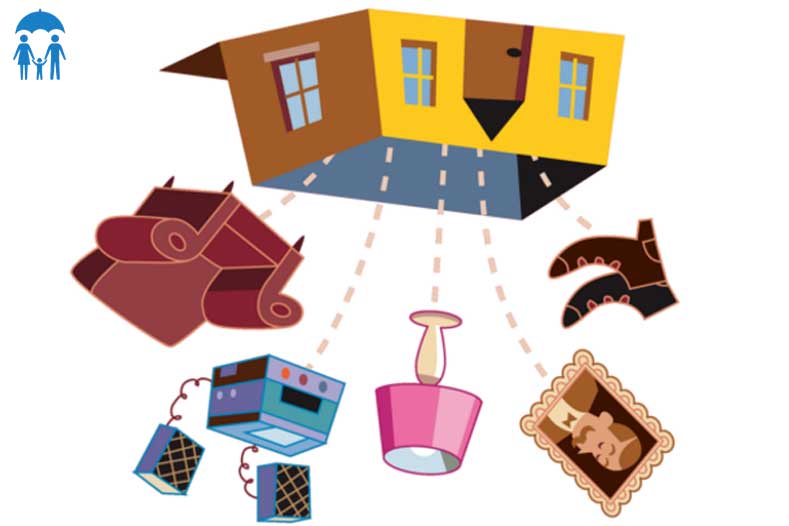Contents insurance
Contents insurance covers the financial cost of repairing or replacing your household personal possessions and furnishings, such as curtains, furniture, white goods, stereo, TV, computers and other electrical appliances, clothing, jewellery, sporting equipment and even toys.
This insurance covers household items belonging to you, and to family members who live with you. These policies may also include items such as sporting gear and motorised wheelchairs but do not include items permanently attached to the building or insured address or portable items you might take outside your home. You can take out extra cover to protect things like your jewellery, cameras, mobile phones and sporting equipment (but not when in use) from accidental loss or damage.
These policies don’t usually include cover for items friends or visitors bring into your premises, unless you list their names on the policy.
Contents insurance is suitable for home owners and renters. Home owners can purchase it as a stand-alone product or buy it in combination with home insurance as a home contents policy. Renters can also purchase low-cost renter’s insurance policies.
If you are a renter or tenant, your possessions are not covered by your landlord’s insurance policies.
Types of contents insurance
The two main types of contents insurance are replacement value and new for old.
Most policies offer consumers new-for-old cover. This means you are covered for the full cost of replacing lost or damaged possessions with new possessions, which have a higher dollar value. You will generally pay a higher premium for new-for-old cover.
A replacement value insurance policy covers only the value of your possessions – and the value of most items depreciates each year. This is why it is important to review your policy regularly and ensure your insurance is up to date.
What are you covered for?
You can choose different levels of cover under a contents policy. The least expensive option, which gives you the bare minimum of cover, is a defined events policy, which would typically only cover your belongings if they were lost through defined events such as fire or if you were burgled.
For a much broader level of coverage , policies that include accidental damage will protect you against the cost of incidents such as accidental breakage, or even a stain on a lounge or carpet.
Some contents policies may also give you the option to cover some of your personal possessions or valuables away from home, such as sports equipment, jewellery or cameras, though there is usually a limit for unspecified items. Check with your insurer to see what restrictions apply.
Most contents policies have fixed, unfixed or flexible limits on how much you can normally claim for certain items. For example, your contents policy may only pay up to $500 for a ring, even if it would cost $2000 to replace.
Valuable items may need to be insured for a higher specific value or listed separately under your policy otherwise they might not be covered for their full value or may be excluded from a claim.
It’s important that you get a separate valuation for expensive items such as jewellery, and make sure they are listed individually in your policy. You may need to pay an additional premium to properly insure all valuable items.
You should also declare anything that could be classified as a collection to your insurer, such as DVDs, rare books or stamps.
Having enough contents insurance
Many people underestimate the value of their contents, particularly if they haven’t written down what they own or haven’t updated a contents inventory list for a while. It’s easy to forget to add new things you have purchased recently and gifts you have received.
When working out what level of contents insurance you need, start by listing all your belongings and assess how much it would cost to replace them at today’s prices.
When cataloguing your belongings keep your list as detailed as possible. Serial numbers, receipts, photos and information about the condition and year items were purchased will help you work out how much to insure for. This list, along with documents showing proof of ownership, may be helpful if you need to make a claim.
By reviewing your contents inventory each year and updating your policy, you can help make sure you are always fully covered. The annual renewal of your insurance policy is a good reminder to review and update your home contents inventory, and make sure your amount insured is accurate.
Many insurers have inventory apps for smartphones and portable electronic devices, as well as downloadable online programs that may help you put together your own home contents inventory.
Non-insurance, underinsurance and averaging
Though most people insure their homes, more than one-third do not insure their contents.
If something unexpected happened, such as a fire, how would you replace your clothes, furniture, white goods and electronic items without the help of insurance? Would you have enough savings, or would you have to rely on family, friends and charities to recover?
Underinsurance — when the policyholder takes out insurance that covers less than the value of their possessions — is widespread. In many instances, this is a deliberate if misguided decision to help reduce the premium.
This can work against the policyholder because most insurers apply averaging when a claim is made. This means the insurer will review the contents of the property, calculate the level of underinsurance and reduce the settlement amount in proportion to the underinsurance. This is outlined in the Product Disclosure Statement (PDS).
If the value of your household possessions at the time of a loss is greater than the value you insured them for, you are underinsured by the difference in value. For example, if you insure your contents for $25,000 and they are all damaged and they cost $50,000 to replace in a total loss event, an insurer will never pay more than the $25,000 sum insured.
If you are underinsured and you suffer a partial loss your insurer may apply averaging techniques when a claim is made. This is means the insurer will review the contents of the property, calculate the level of underinsurance and reduce the settlement amount in proportion to the underinsurance. This is outlined in the PDS.
For example, if $10,000 of your contents were damaged in a partial loss and only 50 per cent of the contents replacement value was insured, then the claim may be settled for only $5000 leaving you $5000 out of pocket.
How premiums are calculated?
The premium for contents insurance is based on the likelihood of a claim being made on your policy in the future. Your insurer may take into account many different factors when calculating your premium, including:
✓ The basic excess amount you choose
✓ The age of the person buying the policy, and other people the policy covers
✓ The amount your contents are insured for (your sum insured)
✓ The level of cover you have chosen
✓ How your home is occupied
✓ Location of your home
✓ How you use your home (for example, whether you are operating a home-based business)
✓ The risk profile of the location, including crime rates and the risk of natural perils such as floods, bushfires and cyclones
✓ Security measures fitted to your home
Discounts and savings
Insurance companies may reduce your premium if certain safety and security measures are in place, such as deadbolt locks, fire extinguishers, smoke alarms and security systems. In some cases, these items may be required under the policy.
Once your premium is calculated your insurer can then work out if you are eligible for any discounts such as:
✓ Linked policy discount
✓ Multi-policy discount
✓ Years of insurance discount
✓ No-claims bonus
The discounts you have will be shown on your current Certificate of Insurance.
What else is included?
The final amount you pay will also include:
✓ State and territory government stamp duties. These range from 11 per cent to 6 per cent (ACT). These are applied after the GST. In NSW, each policy includes an Emergency Services Levy (ESL) that helps fund fire and other emergency services, which is applied to the policy before any other taxes. The ESL is applied to the premium before the 10 per cent GST and 10 per cent stamp duty
✓ Goods and Services Tax (GST) is an additional 10 per cent of the premium



